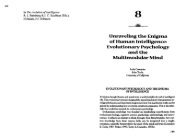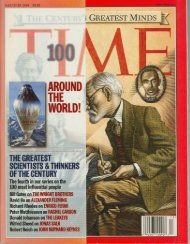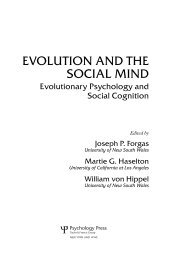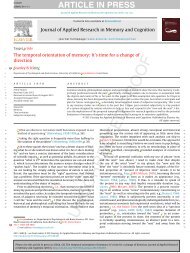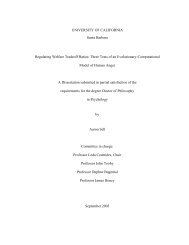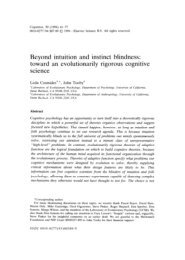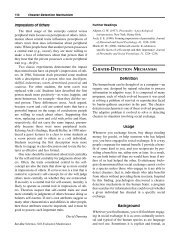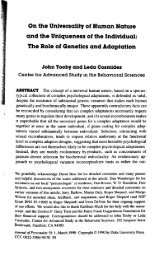Evolution of Fairness - Center for Evolutionary Psychology
Evolution of Fairness - Center for Evolutionary Psychology
Evolution of Fairness - Center for Evolutionary Psychology
Create successful ePaper yourself
Turn your PDF publications into a flip-book with our unique Google optimized e-Paper software.
COMMENTARY<br />
Seeds <strong>of</strong> change<br />
Spore propulsion<br />
392<br />
395<br />
LETTERS I BOOKS I POLICY FORUM I EDUCATION FORUM I PERSPECTIVES<br />
LETTERS<br />
edited by Jennifer Sills<br />
Bracing <strong>for</strong> Oil<br />
UNEASINESS HAS SETTLED ON THE UNIVERSITY OF MIAMI’S ROSENSTIEL<br />
School <strong>of</strong> Marine and Atmospheric Science campus as we watch the<br />
oil spill slick creep across the Gulf. Although we are on Florida’s<br />
eastern side, the currents will likely carry the oil to our shores. What<br />
would become <strong>of</strong> the beach surrounding our campus, and the reefs just<br />
<strong>of</strong>fshore that we measure and map and monitor regularly?<br />
On campus, we have set up our own drilling rigs, drilling not <strong>for</strong><br />
Creeping closer. Weeks after the April 2010 Gulf <strong>of</strong> Mexico oil spill began, a<br />
wave <strong>of</strong> oily tarballs washes over a footprint in Orange Beach, Alabama.<br />
oil, but <strong>for</strong> clean seawater. The tanks housing our corals and fish draw<br />
water directly from Biscayne Bay, and we hoped that by digging wells,<br />
we could use sand to filter out the incoming pollutants. Results are<br />
mixed: One <strong>of</strong> the wells has produced water <strong>of</strong> high quality, but the<br />
other has high loads <strong>of</strong> inorganic nutrients, rendering its utility questionable<br />
and the security <strong>of</strong> the water supply uncertain.<br />
It is hard to predict how the oil will affect our reefs. Many <strong>of</strong> the<br />
studies on the effects <strong>of</strong> oil and dispersants on corals were done in the<br />
1970s and early 1980s (1, 2). Although many sublethal effects were<br />
reported, acute mortality in connection with oil alone was low. The<br />
mucous layer <strong>of</strong> corals may allow them to slough <strong>of</strong>f oil be<strong>for</strong>e it causes<br />
damage. The dispersants are more toxic; they can dissolve the corals’<br />
mucous layer, which would allow chemicals to penetrate the tissues.<br />
Our predictive capacity is further compromised by the wide range <strong>of</strong><br />
secondary stressors, including coral bleaching, ocean acidification,<br />
disease outbreaks, and algal overgrowth. These factors might make<br />
the corals even more vulnerable, particularly to toxic exposures.<br />
Powerless, we wait and watch, trying to enjoy our beach but always<br />
mindful <strong>of</strong> the days, perhaps not far <strong>of</strong>f, when tarballs will mingle<br />
with the seaweed washed ashore. As we work to mitigate this disaster,<br />
we must go beyond a clean up and demand better protection <strong>for</strong> these<br />
devastated and dwindling ecosystems.<br />
RACHEL N. SILVERSTEIN<br />
Rosenstiel School <strong>of</strong> Marine and Atmospheric Science, University <strong>of</strong> Miami, Miami, FL<br />
33149, USA. E-mail: rsilverstein@rsmas.miami.edu<br />
References<br />
1. Y. Loya et al., Oil Petroch. Poll. 1, 157 (1983).<br />
2. Y. Loya, B. Rinkevich, Mar. Ecol. Prog. Ser. 3, 167 (1980).<br />
Downloaded from www.sciencemag.org on August 3, 2010<br />
<strong>Evolution</strong> <strong>of</strong> <strong>Fairness</strong>:<br />
Cultural Variability<br />
J. HENRICH ET AL. (“MARKETS, RELIGION, COMmunity<br />
size, and the evolution <strong>of</strong> fairness and<br />
punishment,” Research Articles, 19 March, p.<br />
1480) have shown that market integration and<br />
participation in world religion covary with<br />
fairness. The authors suggest that their results<br />
support cultural evolution theories and contradict<br />
the hypothesis that successful social<br />
interactions in large-scale societies arise to a<br />
large extent from an evolved psychology. We<br />
believe that their conclusion is based on too<br />
simple a view <strong>of</strong> human morality.<br />
Much research in behavioral economics<br />
supports the idea that humans have a<br />
sense <strong>of</strong> fairness that aims to equilibrate<br />
exchanges among individuals. In economic<br />
games where money needs to be distributed,<br />
<strong>for</strong> instance, people carefully respect<br />
everyone’s rights over the stake: If the common<br />
good is produced by a single person,<br />
she is granted more rights over the money<br />
(1, 2); similarly, the most productive partner<br />
during the joint production phase is<br />
favored (3, 4).<br />
Economic games are notoriously underdetermined:<br />
Participants are given a lump<br />
<strong>of</strong> money to distribute with no in<strong>for</strong>mation<br />
as to where it comes from, who owned it<br />
in the first place, who the receiver is, and<br />
so on. As the authors have noted in previous<br />
papers (5), participants have no choice<br />
but to fill this in<strong>for</strong>mational gap by drawing<br />
on their everyday life experience. Because<br />
participants in more market-integrated<br />
societies have more experience in sharing<br />
goods and investing with others, they spontaneously<br />
attribute more rights to the other<br />
participant and consequently allow her<br />
more money (6).<br />
This explanation fits better with the economic<br />
literature on institutions and cooperation.<br />
Contrary to what the authors suggest,<br />
Nobel Prize-winning economists Douglas<br />
North (7) and Elinor Ostrom (8) have shown<br />
that cultural variability in cooperation is not<br />
explained by different norms but rather by<br />
different systems <strong>of</strong> incentives (reward and<br />
penalties) organized by local communities or<br />
CREDIT: JAY REEVES/AP PHOTO<br />
388<br />
23 JULY 2010 VOL 329 SCIENCE www.sciencemag.org<br />
Published by AAAS
Adipose signals<br />
States. Thus, an innate preference <strong>for</strong> fairness<br />
is fully compatible with Henrich et al.’s results.<br />
It is also theoretically more parsimonious and<br />
supported by more empirical evidence.<br />
NICOLAS BAUMARD, 1 * PASCAL BOYER, 2<br />
Climate change<br />
on early Mars<br />
397 400<br />
DAN SPERBER 3<br />
1<br />
Department <strong>of</strong> Anthropology, Institute <strong>of</strong> Cognitive and<br />
<strong>Evolution</strong>ary Anthropology, University <strong>of</strong> Ox<strong>for</strong>d, Ox<strong>for</strong>d<br />
OX2 6PN, UK. 2 Department <strong>of</strong> <strong>Psychology</strong>, Washington University,<br />
St. Louis, MO 63130, USA. 3 Department <strong>of</strong> Philosophy,<br />
Central European University, 1051 Budapest, Hungary.<br />
*To whom correspondence should be addressed. E-mail:<br />
nbaumard@gmail.com<br />
References<br />
1 R. J. Oxoby, J. Spraggon, J. Econ. Behav. Org. 65, 703<br />
(2008).<br />
2. T. L. Cherry, P. Frykblom, J. F. Shogren, Am. Econ. Rev.<br />
92, 1218 (2002).<br />
3. N. Frohlich, J. Oppenheimer, A. Kurki, Public Choice 119,<br />
91 (2004).<br />
4. A. W. Cappelen, A. D. Hole, E. O. Sorensen, B. Tungodden,<br />
Am. Econ. Rev. 97, 818 (2007).<br />
5. J. Henrich et al., Behav. Brain Sci. 28, 795 (2005).<br />
6. N. Baumard, D. Sperber, Behav. Brain Sci. 33, 60 (2010).<br />
7. D. C. North, Institutions, Institutional Change, and<br />
Economic Per<strong>for</strong>mance (Cambridge Univ. Press,<br />
Cambridge, 1990).<br />
8. E. Ostrom, Governing the Commons: The <strong>Evolution</strong><br />
<strong>of</strong> Institutions <strong>for</strong> Collective Action (Cambridge Univ.<br />
Press, Cambridge, 1990).<br />
<strong>Evolution</strong> <strong>of</strong> <strong>Fairness</strong>:<br />
Rereading the Data<br />
J. HENRICH ET AL.’S RESEARCH ARTICLE<br />
(“Markets, religion, community size, and<br />
the evolution <strong>of</strong> fairness and punishment,”<br />
19 March, p. 1480) is a valuable addition<br />
to the growing literature testing behavioral<br />
hypotheses through careful cross-cultural<br />
measurement. However, the data they report<br />
falsify their theory. The authors propose<br />
that increases in third-party punishment<br />
<strong>of</strong> unfairness drove an increase in fairness<br />
norms, enabling the emergence <strong>of</strong> large-scale<br />
market economies. Critical to this theory is<br />
their hypothesis that exposure to third-party<br />
punishment actually elicits an increase in<br />
fairness. Relevant to evaluating this hypothesis,<br />
the authors conducted two near-parallel<br />
economic games: a Dictator Game (in which<br />
a “dictator” unilaterally divides a windfall<br />
gain with another person—a measure<br />
<strong>of</strong> fairness) and a Third-Party Punishment<br />
Game (the Dictator Game with the addition<br />
<strong>of</strong> exposure to possible third-party punishment).<br />
Their central hypothesis requires that<br />
adding punishment to the Dictator Game<br />
will increase fairness, but their data show<br />
that the addition <strong>of</strong> punishment decreases<br />
fairness (p. 1483). This finding unambiguously<br />
refutes their central hypothesis.<br />
Henrich et al. also assert that their data—<br />
showing patterned cultural variability in<br />
cooperation—can determine whether modern<br />
levels <strong>of</strong> generosity and altruism are<br />
driven by an evolved social psychology or<br />
by cultural processes. The authors claim that<br />
their data decisively favor the cultural processes<br />
hypothesis. Yet nothing in their data<br />
can test (even in principle) whether it is psychological<br />
or cultural processes (or both)<br />
that cause these cross-cultural differences.<br />
Only long-abandoned instinct-as-reflex<br />
theories expect invariant responses in the<br />
face <strong>of</strong> different social inputs. By contrast,<br />
modern adaptationist theories predict that<br />
our evolved social psychology will be calibrated<br />
by relevant environmental inputs.<br />
Many <strong>of</strong> these inputs—such as the local<br />
value <strong>of</strong> long-term cooperative relationships<br />
and the fidelity <strong>of</strong> reputations—are likely<br />
to covary with market integration, making<br />
it at least as likely that an evolved, contextsensitive<br />
social psychology is driving the<br />
results that the authors observe. That is,<br />
psychological and cultural theories both predict<br />
cross-cultural variation.<br />
ANDREW W. DELTON, MAX M. KRASNOW,<br />
LEDA COSMIDES, JOHN TOOBY*<br />
<strong>Center</strong> <strong>for</strong> <strong>Evolution</strong>ary <strong>Psychology</strong>, University <strong>of</strong> Cali<strong>for</strong>nia,<br />
Santa Barbara, CA 93106–9660, USA.<br />
*To whom correspondence should be addressed. E-mail:<br />
tooby@anth.ucsb.edu<br />
Response<br />
OUR RESEARCH ARTICLE DOES NOT ARGUE<br />
that elements <strong>of</strong> an evolved social psychology<br />
are unimportant, as Baumard et al. suggest.<br />
Nor do we believe, as Delton et al.<br />
propose, that purely genetically evolved<br />
mechanisms, rooted in kinship and reciprocity,<br />
are sufficient to account <strong>for</strong> the massive<br />
expansion <strong>of</strong> cooperation in the past 10 millennia<br />
and the diversity <strong>of</strong> human sociality.<br />
We argue that understanding this expansion<br />
requires the integration <strong>of</strong> work on both cultural<br />
and genetic evolution.<br />
Baumard et al. misunderstand the work<br />
we cite on the evolution <strong>of</strong> norms (1–4), as<br />
well as that <strong>of</strong> North and Ostrom. The cited<br />
work asks two questions <strong>of</strong> innate learning<br />
heuristics: (i) Under what conditions can<br />
these adaptive learning mechanisms yield<br />
self-rein<strong>for</strong>cing stable equilibria (“norms”)<br />
at which individually costly behaviors are<br />
sustained, and (ii) what happens when<br />
groups stuck at different stable equilibria<br />
interact and compete (5)? Thus, we draw on<br />
work that explicitly theorizes the origins and<br />
evolution <strong>of</strong> “incentive systems” given what<br />
we know empirically about human psychology<br />
and learning.<br />
Both our theoretical approach and our<br />
empirical evidence are convergent with<br />
approaches suggested by North and Ostrom,<br />
who have emphasized the importance <strong>of</strong><br />
norms, institutions, and learning and culture<br />
[pp. 89, 17, and 75 in (6); p. 75 in (7); pp. 42,<br />
86, 87, and 135 in (8)].<br />
Baumard et al. claim that much research<br />
supports the idea “that humans have a sense<br />
<strong>of</strong> fairness,” but the four papers they cite are<br />
limited to Dictator Games among undergraduates.<br />
Although we strongly suspect that<br />
there are innate elements to human fairness<br />
(9, 10), the empirical findings cited are neither<br />
applicable to our recent paper nor established<br />
beyond Western undergraduates, who<br />
are but one population in a broad spectrum<br />
<strong>of</strong> human diversity (11, 12).<br />
Baumard et al.’s concerns about underdetermination<br />
in our economic experiments<br />
are unfounded; in the protocols we administered<br />
across 15 diverse populations, property<br />
rights (money was “given to the pair”), the<br />
origins <strong>of</strong> the money, and what players know<br />
(and do not know) about the receiver were<br />
made explicit and held constant across sites.<br />
Analyses using our measures <strong>of</strong> comprehension<br />
and <strong>for</strong>mal education (10), as well as our<br />
post-game interviews, revealed no hint that<br />
systematic misunderstandings <strong>of</strong> the instructions<br />
(e.g., regarding property rights) affected<br />
the findings. Of course, if different populations<br />
hold different learned and internalized norms<br />
from daily life regarding property rights, this<br />
would support our theoretical view.<br />
Letters to the Editor<br />
Letters (~300 words) discuss material published<br />
in Science in the previous 3 months or issues <strong>of</strong><br />
general interest. They can be submitted through<br />
the Web (www.submit2science.org) or by regular<br />
mail (1200 New York Ave., NW, Washington, DC<br />
20005, USA). Letters are not acknowledged upon<br />
receipt, nor are authors generally consulted be<strong>for</strong>e<br />
publication. Whether published in full or in part,<br />
letters are subject to editing <strong>for</strong> clarity and space.<br />
Downloaded from www.sciencemag.org on August 3, 2010<br />
www.sciencemag.org SCIENCE VOL 329 23 JULY 2010 389<br />
Published by AAAS
LETTERS<br />
Finally, Baumard et al. explain the strong<br />
statistical relationship we found between markets,<br />
religion, and community size by noting<br />
that people in market societies have more<br />
experience with “sharing.” Empirically, this<br />
view is inconsistent with substantial anthropological<br />
evidence <strong>for</strong> intensive food sharing,<br />
especially in the smallest-scale societies<br />
(13). Delton et al. also refer to a relationship<br />
between market integration with “cooperative<br />
relationships” and the “fidelity <strong>of</strong> reputations,”<br />
implying that in the smallest-scale<br />
human societies (such as <strong>for</strong>agers), long-term<br />
cooperative relationships have relatively less<br />
value than among Americans, and that reputations<br />
in these face-to-face communities have<br />
lower fidelity than among Western urbanites.<br />
Such a proposal runs contrary to all available<br />
evidence (14, 15).<br />
Delton et al.’s concerns about the relationship<br />
between our Dictator Game (DG) and<br />
Third-Party Punishment Game (TPG) stem<br />
from their belief that our approach assumes<br />
that only social norms affect experimental<br />
results. However, we argue that culturally<br />
evolved norms influence decision-making<br />
along with other factors (such as material<br />
costs and benefits), which is why we equalized<br />
the stakes across sites and controlled<br />
<strong>for</strong> income and wealth. Reflecting this, we<br />
proposed that the drop in TPG <strong>of</strong>fers relative<br />
to the DG arises from the interaction <strong>of</strong><br />
two factors (pp. 56 to 61 in our supporting<br />
online material). First, empirical work suggests<br />
that when punishments or rewards are<br />
CORRECTIONS AND CLARIFICATIONS<br />
added to a situation, they may reduce intrinsic<br />
motivations toward some goal or norm<br />
(16). If punishing is structurally limited or<br />
weak, the net effect <strong>of</strong> adding this threat to<br />
a social interaction may be to reduce motivations<br />
to be social. However, if the punishment<br />
threat is increased, the net result will<br />
be greater social behavior than in the nonincentivized<br />
situation. Second, our TPG adds<br />
only limited punishment to a DG. The most<br />
our punishers can do is to reduce a players’<br />
take by 30%. Consequently, it seems likely<br />
that <strong>of</strong>fers went down in our TPG because<br />
the game adds a punishment threat (reducing<br />
intrinsic motivations) but provides limited<br />
punishment opportunities—creating<br />
insufficient compensatory incentives. This<br />
explains why punishment increased <strong>of</strong>fers<br />
slightly in the Ultimatum Game (UG), relative<br />
to the DG, whereas it reduced <strong>of</strong>fers<br />
in the TPG; the UG has potent punishment.<br />
Thus, TPG mean <strong>of</strong>fers could be raised<br />
by increasing the opportunities <strong>for</strong> punishment.<br />
This underlines the fact that our<br />
experiments were not designed to assess the<br />
relative efficacy <strong>of</strong> third-party punishment<br />
on prosocial outcomes, but rather to compare<br />
a fixed punishment opportunity across<br />
populations. Analyses <strong>of</strong> the differences in<br />
DG and TPG <strong>of</strong>fers (table S18 in our supporting<br />
online material) suggest that adding<br />
limited punishment reduces those prosocial<br />
motivations linked to world religions.<br />
We agree that applying evolutionary theory<br />
can generate context-dependent theories<br />
This Week in Science: “Glacial gas” (25 June, p. 1609). The first five words should not have run. The first sentence should<br />
read, “A series <strong>of</strong> sudden and large warming episodes, called Dansgaard-Oeschger events, interrupted the cold conditions<br />
<strong>of</strong> the last glacial period.” The sentence has been corrected in the HTML version online.<br />
Editors’ Choice: “Caught in the net” by C. Ash (11 June, p. 1328). In the second sentence, “apatite skeletons” should<br />
have been “aragonite skeletons.”<br />
News <strong>of</strong> the Week: “APA seeks to overhaul personality disorder diagnoses” by C. Holden (12 March, p. 1314). Andrew<br />
Skodol was incorrectly identified. He is a psychiatrist at the University <strong>of</strong> Arizona College <strong>of</strong> Medicine in Tucson.<br />
Cover Caption: (26 February, p. 1049). The cover caption did not sufficiently acknowledge the airborne laser mapping<br />
project called “B4.” In the image credit, the following should have been added parenthetically after “the B4 Project”:<br />
“(Ohio State University, U.S. Geological Survey, National <strong>Center</strong> <strong>for</strong> Airborne Laser Mapping, UNAVCO, and Optech International;<br />
www.earthsciences.osu.edu/b4).”<br />
Reports: “Slip in the 1857 and earlier large earthquakes along the Carrizo Plain, San Andreas Fault” by O. Zielke et al.<br />
(26 February, p. 1119). In note 11, the description <strong>of</strong> the source <strong>of</strong> the data used in this study was incomplete, and in<br />
note 28, the airborne laser mapping project called “B4” was insufficiently acknowledged. Note 11 should have read:<br />
“This LiDAR point cloud was gathered by the National <strong>Center</strong> <strong>for</strong> Airborne Laser Mapping using an Optech ALTM 3100<br />
in a Cessna 310 aircraft flying at 600 m above ground level with a 70-kHz pulse rate and ±20° scan angle. The ~1-kmwide<br />
survey comprised five overlapping swaths. These data are version 1.01 <strong>of</strong> the B4 project data, which use Kendrick’s<br />
26 November 2005 GPS processing with the KARS s<strong>of</strong>tware. Points with location accuracies <strong>of</strong> better than a few decimeters<br />
have densities <strong>of</strong> 2 to 4 per m 2 along the 1857 reach, which allowed us to download 0.25 to 0.5 m per pixel Digital<br />
Elevation Models computed using a local binning approach (www.opentopography.org).” The following line should have<br />
appeared at the end <strong>of</strong> note 28: “The ‘B4 Project’ (www.earthsciences.osu.edu/b4) collected LiDAR point cloud data along<br />
the southern San Andreas and San Jacinto Faults. Data acquisition and processing were per<strong>for</strong>med by the National <strong>Center</strong><br />
<strong>for</strong> Airborne Laser Mapping (NCALM). The project was led by Ohio State University and USGS with funding from the<br />
Division <strong>of</strong> Earth Sciences Geophysics program at the NSF. Optech International contributed the ALTM3100 laser scanner.<br />
UNAVCO and Southern Cali<strong>for</strong>nia Integrated GPS Network assisted in GPS ground control. Numerous volunteers and landowners<br />
made the project possible.”<br />
about psychology (9, 17). However, when<br />
one takes the classic models seriously, without<br />
applying ad hoc verbal extensions, the<br />
implications are clear: Genetic mechanisms<br />
based on kinship, reciprocity, and signaling<br />
are alone insufficient to account <strong>for</strong> the<br />
scale, temporal trajectory, and variation in<br />
human cooperation (9, 18, 19).<br />
JOSEPH HENRICH, 1 * JEAN ENSMINGER, 2 RICHARD<br />
MCELREATH, 3 ABIGAIL BARR, 4 CLARK BARRETT, 5<br />
ALEXANDER BOLYANATZ, 6 JUAN CAMILO CARDE-<br />
NAS, 7 MICHAEL GURVEN, 8 EDWINS GWAKO, 9 NATA-<br />
LIE HENRICH, 10 CAROLYN LESOROGOL, 11 FRANK<br />
MARLOWE, 12 DAVID TRACER, 13 JOHN ZIKER 14<br />
1<br />
Departments <strong>of</strong> <strong>Psychology</strong> and Economics, University <strong>of</strong><br />
British Columbia, 2136 West Mall, Vancouver, BC V6T 1Z4,<br />
Canada. 2 Division <strong>of</strong> the Humanities and Social Sciences,<br />
Cali<strong>for</strong>nia Institute <strong>of</strong> Technology, Pasadena, CA 91125,<br />
USA. 3 Department <strong>of</strong> Anthropology, University <strong>of</strong> Cali<strong>for</strong>nia,<br />
Davis, CA 95616, USA. 4 Centre <strong>for</strong> the Study <strong>of</strong> African<br />
Economies, Department <strong>of</strong> Economics, University <strong>of</strong><br />
Ox<strong>for</strong>d, Manor Road, Ox<strong>for</strong>d OX1 3UQ, UK. 5 Department<br />
<strong>of</strong> Anthropology, University <strong>of</strong> Cali<strong>for</strong>nia, 341 Haines Hall,<br />
Box 951553, Los Angeles, CA 90095, USA. 6 Department<br />
<strong>of</strong> Anthropology, College <strong>of</strong> DuPage, Glen Ellyn, IL 60137,<br />
USA. 7 Facultad de Economia, Universidad de Los Andes,<br />
K1 Number 18A-70, Bogotá, Colombia. 8 Department <strong>of</strong><br />
Anthropology, University <strong>of</strong> Cali<strong>for</strong>nia, Santa Barbara, CA<br />
93106, USA. 9 Department <strong>of</strong> Sociology and Anthropology,<br />
Guil<strong>for</strong>d College, 5800 West Friendly Avenue, Greensboro,<br />
NC 27410, USA. 10 Centre <strong>for</strong> Health Evaluation and Outcome<br />
Sciences, Providence Health Care Research Institute,<br />
Vancouver, BC V6Z 1Y6, Canada. 11 George Warren Brown<br />
School <strong>of</strong> Social Work, Washington University, 1 Brookings<br />
Drive, St. Louis, MO 63130, USA. 12 Department <strong>of</strong><br />
Anthropology, Florida State University, Tallahassee, FL<br />
32306, USA. 13 Department <strong>of</strong> Anthropology, University<br />
<strong>of</strong> Colorado, Post Offi ce Box 173364, Campus Box 103,<br />
Denver, CO 80217, USA. 14 Department <strong>of</strong> Anthropology,<br />
Boise State University, 1910 University Drive, Boise, ID<br />
83725, USA.<br />
References<br />
1. J. Henrich, R. Boyd, J. Theor. Biol. 208, 79 (2001).<br />
2. K. Panchanathan, R. Boyd, Nature 432, 499 (2004).<br />
3. H. Gintis, E. A. Smith, S. Bowles, J. Theor. Biol. 213, 103<br />
(2001).<br />
4. J. Henrich, J. Econ. Behav. Organ. 53, 3 (2004).<br />
5. J. Henrich, Science 312, 60 (2006).<br />
6. D. C. North, Structure and Change in Economic History<br />
(Norton, New York, ed. 1, 1981).<br />
7. D. C. North, Understanding the Process <strong>of</strong> Economic<br />
Change (Princeton Univ. Press, Princeton, NJ, 2005).<br />
8. D. C. North, Institutions, Institutional Change, and<br />
Economic Per<strong>for</strong>mance (Cambridge Univ. Press,<br />
New York, 1990).<br />
9. N. Henrich, J. Henrich, Why Humans Cooperate:<br />
A Cultural and <strong>Evolution</strong>ary Explanation (Ox<strong>for</strong>d Univ.<br />
Press, Ox<strong>for</strong>d, 2007).<br />
10. J. Henrich et al., Science 312, 1767 (2006).<br />
11. J. Henrich, S. J. Heine, A. Norenzayan, Behav. Brain Sci.,<br />
10.1017/S0140525X0999152X (2010).<br />
12. B. Herrmann, C. Thöni, S. Gächter, Science 319, 1362<br />
(2008).<br />
13. M. Gurven, Behav. Brain Sci. 27, 543 (2004).<br />
14. J. Henrich et al., Behav. Brain Sci. 28, 838 (2005).<br />
15. F. Marlowe, The Hadza: Hunter-Gatherers <strong>of</strong> Tanzania:<br />
Origins <strong>of</strong> Human Behavior and Culture (Univ. <strong>of</strong><br />
Cali<strong>for</strong>nia Press, Berkeley, CA, 2010).<br />
16. S. Bowles, Science 320, 1605 (2008).<br />
17. M. Gurven, Behav. Brain Sci. 27, 572 (2004).<br />
18. R. Boyd, P. J. Richerson, Philos. Trans. R. Soc. Ser. B 364,<br />
3281 (2009).<br />
19. E. Fehr, J. Henrich, in Genetic and Cultural <strong>Evolution</strong> <strong>of</strong><br />
Cooperation, P. Hammerstein, Ed. (MIT Press, Cambridge,<br />
MA, 2003), pp. 55–82.<br />
Downloaded from www.sciencemag.org on August 3, 2010<br />
390<br />
23 JULY 2010 VOL 329 SCIENCE www.sciencemag.org<br />
Published by AAAS



